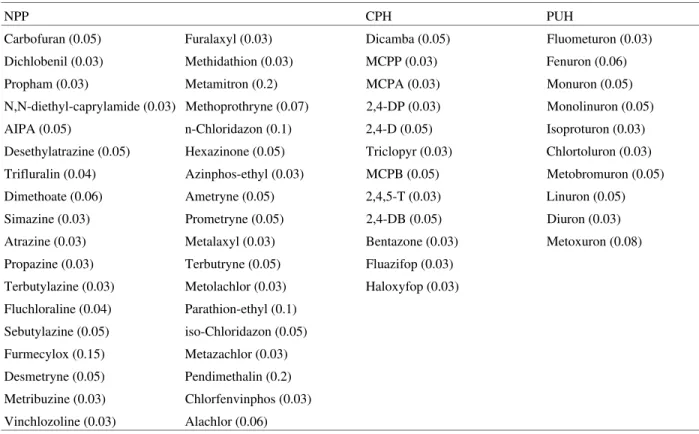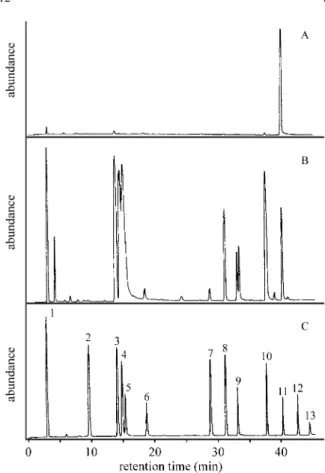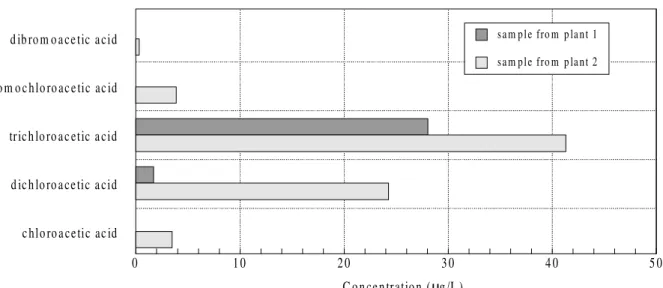Organic Residues in Lake and Drinking Water from the Lagoa de
Juturnaíba (Região dos Lagos - RJ, Brazil)
Marcus Stumpfa,b, Klaus Haberera, Silvana V. Rodriguesc, and Wolfram Baumannb
a
ESWE-Institut für Wasserforschung und Wassertechnologie GmbH,
65201 Wiesbaden, Germany b
Institute of Physical Chemistry, University of Mainz, 55099 Mainz, Germany c
Departamento de Química Analítica, Instituto de Química,
Universidade Federal Fluminense 24.220-000 Niterói - RJ, Brazil
Received: September 7, 1996
Various analytical methods for the determination of organic residues in water were applied to samples from the Lagoa de Juturnaíba in the Região dos Lagos, east of Rio de Janeiro. The concentrations of more than 60 pesticides and of different aminopolycarboxylic acids were deter-mined using GC/MS detection, and a GC/MS screening procedure was applied to detect additional compounds. None of the investigated pesticide residues could be detected in the lake water at detection limits of less than 100 ng/L. EDTA was detected at a concentration level of 2 µg/L in the lake and in drinking water prepared from this lake. Traces of biphenyl were identified by GC/MS in the lake water, the source of which may be its use in impregnating citrus fruit packaging. The drinking water produced from the lake by two different water treatment plants was investigated with respect to disinfection by-products (DBPs), such as chlorinated organic acids. The concentration of the investigated DBPs was as high as 180 µg/L in one sample. The AOX of this sample was 428 g/L.
Diversos métodos analíticos de determinação de resíduos orgânicos em água foram aplicados a amostras tomadas da lagoa de Juturnaíba, na Região dos Lagos, a leste do Rio de Janeiro. As concentrações de mais de 60 pesticidas e de diferentes ácidos aminopolicarboxílicos foram deter-minadas usando-se a técnica de GC/MS; o procedimento de varredura GC/MS foi aplicado na detecção de compostos adicionais. Nenhum dos resíduos de pesticidas investigados pôde ser detectado na água da lagoa, a limites de detecção de menos de 100 ng/L, na maioria dos casos. EDTA foi detectado em níveis de concentração de 2 µg/L no lago e na água potável preparada com água da lagoa. Traços de bifenil foram identificados por GC/MS na água da lagoa - sua origem pode ser o uso dessa substância para impregnação da embalagem de frutas cítricas. A água potável captada na lagoa em duas diferentes estações de tratamento foi investigada com respeito a subprodutos de desinfecção (DBPs), tais como ácidos orgânicos clorados. A concentração dos DBPs investigados chegou a 180 µg/L em uma das amostras. A concentração de AOX nesta amostra foi de 428 µg/L.
Keywords: pesticides, aminopolycarboxylic acids, disinfection by-products, GC/MS, drinking water quality
Introduction
The results from organic trace analyses presented here were obtained within the framework of two related pro-jects. The first one, a PROBRAL-project supported by
CAPES/Brazil and DAAD/Germany studies the effect on the water quality of the varying water levels of the Lagoa de Juturnaíba, ~100 km east of Rio de Janeiro, and the varying influent and effluent ground water conditions, as
Article
well as the related variations in the algae populations. The second project which is supported by the Instituto Acqua, Rio de Janeiro, is aimed towards the estimation of the drinking water quality and quantity in the Região dos Lagos, in the same area east of Rio de Janeiro.
Sampling
In May 1995, water samples were taken from the Lagoa de Juturnaíba (Região dos Lagos, Brazil), at that time at a relatively low water level, and from two water treatment plants which use the lake water as the source for the preparation and distribution of drinking water. The treat-ment steps are aeration, flocculation, sand filtration, and disinfection by chlorination. A series of samples was drawn after each of the different treatment steps at plant 1, and tap water from plant 2 was sampled at Araruama, a small town about 40 km from the treatment plant. The samples were stored at 4 °C for two days and then sent to the German laboratory by air, so that sample preparation and the sub-sequent analysis could be started within three days after sampling.
Experimental
Various organic water pollutants, such as pesticides, aminopolycarboxylic acids and disinfection by-products from a large range of polarities (neutral to acidic) were investigated by different sample preparation and detection methods. Detection was performed by gas chromatography (GC) coupled to either mass spectrometry (MS) using a Hewlett Packard 5890 Series II GC instrument coupled to a Hewlett Packard 5971 MSD, by a Varian Star 3400 GC with an electron capture detector (ECD), or by a Hewlett Packard 5890 GC with a nitrogen phosphorous detector (NPD). In most cases, the applied methods had detection limits in the range of 30 to 100 ng/L. In addition, screening for unknown compounds by the GC/MS-full scan tech-nique was performed. Sum parameters, such as dissolved organic carbon (DOC) and adsorbable organic halogen (AOX), were determined following DIN 38409 part 3 or part 14. The instruments used included a Maihak TOCOR 4 and a Euroglas ECS 1600, respectively. All samples were filtered through 0.45 µm glass fiber filters before further treatment. Quantification was performed using four-point calibration curves over the full useful range of the applied methods. All solvents were of Merck SupraSolv quality. The overall relative standard error of concentration determined by the gaschromatographic techniques was around 10 to 20%, and that of the DOC and AOX determinations was 10 to 15%.
Pesticides
Non-polar pesticides
The sample preparation for non-polar pesticides (NPP) was done by analyte enrichment from 1 L water samples
into a mixture of 250 mg RP-C18 (Lichrolute RP-C18,
Merck) and 100 mg EN (Lichrolute EN, Merck) at pH 7. After drying the solid phase (N2, 45 min), the analytes were
eluted by 3 mL acetone. The extracts were concentrated to 1 mL by evaporation, and an internal standard (1 µg hep-tadecanoic nitrile) was spiked before detection by GC/MS-selected ion monitoring (SIM)1.
Phenylurea herbicides
The phenylurea herbicides (PUHs) were concentrated and eluted under the same conditions as the NPPs. The extracts were dried by evaporation and derived with NaH/CH3I in dioxane to the respective
N-methyl-pheny-lurea herbicides2. After liquid/liquid extraction from the reaction mixture and the addition of an internal standard (0.75 µg Fluazifop-butyl), a GC/MS-SIM determination was performed.
Chlorophenoxy herbicides
For the determination of chlorophenoxy herbicides (CPHs), a 1 L water sample was adjusted to pH 2 and concentrated on the above-described mixed solid phase (RP-C18/EN). After drying, the analytes were eluted with
3 mL methanol. The eluent was evaporated to dryness by a smooth nitrogen flux, and then derivation to the methyl ester was performed by adding 0.8 mL hexane and 0.2 mL of a ~5% diazomethane/diethyl ether solution (1 h, room temperature). Quantitative analysis by GC/MS-SIM was done after spiking the sample with 1 µg heptadecanoic nitrile as the internal standard.
Aminopolycarbonic acids
The aminopolycarboxylic acids NTA, EDTA and DTPA were concentrated from 100 mL samples (pH 4) on 1 g of a strong anion exchanger (SAX, Isolute). After drying the analytes were eluted with 3 x 1 mL acetic acid (16 M). After evaporation to dryness at 85 °C the ami-nopolycarboxylic acids were derived to the respective iso-propyl esters with acetylchloride/isopropanol. After liquid/liquid extraction from the reaction mixture, the quantitative analysis was performed using a Hewlett Packard 5890 gas chromatograph equipped with a nitro-gen/phosphorous detector3.
Disinfection by-products
Screening for unknown compounds
The extracts from neutral and acidic solid/liquid and subsequent liquid/liquid-extractions of 1 L samples were concentrated under partial reflux5 to a final volume of 20 µL. Thus the analytes were concentrated by up to 50000 times. These concentrates were then screened by a GC/MS-full scan.
Results
Pesticides
A powerful analytic instrumentation, GC/MS allows the simultaneous determination of a large number of or-ganic compounds with similar polarity. The limit of detec-tion (LOD) was 30-100 ng/L in most cases. Table 1 lists all of the investigated pesticides of the three studied groups.
None of these compounds in the water samples from the lake were detectable with concentrations above the detec-tion limits shown in brackets in Table 1. The samples taken from the different treatment stages at plant 1, as well as the tap water sample from plant 2 were also found to be free from residues of the investigated pesticides at this detection limit.
Aminopolycarbonic acids
NTA and EDTA were detectable in the lake water, NTA at 0.5 µg/L and EDTA at the 2 µg/L level, their origin in
this region most probably being household soap-powders and detergents. The water treatment plants cannot eliminate EDTA, and thus EDTA was found at the same concentra-tion in the tap water. This result is not surprising, since it has been shown that only adsorption on active carbon6 or
underground passage7 can reduce concentrations of EDTA
in the treatment of drinking water.
For comparison, concentrations of up to 27 µg/L of EDTA have been detected in German tap water8. EDTA is
not very toxic (LD50 is 2.5 g/kg for rats9), and
remobiliza-tion of heavy metals only occurs at concentraremobiliza-tions, above 100 µg/L10.
Disinfection by-products
In Fig. 1, GC/ECD chromatograms of the detected neutral disinfection by-products are shown. It can be seen from chromatogram A that before chlorination only traces of DBPs could be seen with concentrations below or around the detection limits. After Cl2 treatment, high DBP peaks
appeared (chromatogram B, Fig. 1), which could be iden-tified by comparison with a chromatogram of a standard mixture (C in Fig. 1).
The detected concentrations of neutral and acidic DBPs after chlorination are illustrated in Figs. 2 and 3.
The highest concentration within the group of neutral DBPs was found for chloroform at 40 µg/L, and in the group of acidic DBPs trichloroacetic acid was found at
Table 1. Investigated pesticides and their detection limits, given in brackets as µg/L.
NPP CPH PUH
Carbofuran (0.05) Furalaxyl (0.03) Dicamba (0.05) Fluometuron (0.03) Dichlobenil (0.03) Methidathion (0.03) MCPP (0.03) Fenuron (0.06) Propham (0.03) Metamitron (0.2) MCPA (0.03) Monuron (0.05) N,N-diethyl-caprylamide (0.03) Methoprothryne (0.07) 2,4-DP (0.03) Monolinuron (0.05) AIPA (0.05) n-Chloridazon (0.1) 2,4-D (0.05) Isoproturon (0.03) Desethylatrazine (0.05) Hexazinone (0.05) Triclopyr (0.03) Chlortoluron (0.03) Trifluralin (0.04) Azinphos-ethyl (0.03) MCPB (0.05) Metobromuron (0.05) Dimethoate (0.06) Ametryne (0.05) 2,4,5-T (0.03) Linuron (0.05) Simazine (0.03) Prometryne (0.05) 2,4-DB (0.05) Diuron (0.03) Atrazine (0.03) Metalaxyl (0.03) Bentazone (0.03) Metoxuron (0.08) Propazine (0.03) Terbutryne (0.05) Fluazifop (0.03)
Terbutylazine (0.03) Metolachlor (0.03) Haloxyfop (0.03) Fluchloraline (0.04) Parathion-ethyl (0.1)
41 µg/L. The sum of all of the determined DBPs was 180 µg/L in the plant 1 sample and 78 µg/L in the plant 2 sample. An important parameter for drinking water quality is the sum of trihalomethanes (THMs), which is limited by law to 10 µg/L in Germany11 and to 100 µg/L in Brazil12. The two samples of tap water showed concentrations of THMs of 66 µg/L and 48 µg/L, respectively. The high DBP formation potential presumably results from the high DOC in the water before chlorination (Table 2) and the strong disinfection method (Cl2-gas). The increase of AOX from
13 µg/L to 428 µg/L during water treatment also illustrates the high DBP formation potential (Table 2).
The reasons for the differences in the occurrence of DBPs and their concentrations in the two drinking waters were not investigated. Different disinfection conditions or differing water treatments, as well as the long distance of the sampling location from plant 2 (about 40 km) in com-parison to that from plant 1 (some meters) may be respon-sible for these differences.
Screening for unknown compounds
Extracts from neutral and acidic enrichment procedures in the lake water samples were further concentrated under partial reflux and screened by GC/MS-full scan. The results for pesticide concentrations already indicated that the lake water may be relatively clean from anthropogenic organic residues. The results here further support this impression, since in the chromatograms of the neutral group only one peak could be detected, which was identified by its mass spectrum to be biphenyl. Biphenyl is used to impregnate citrus fruit packaging to prevent the growth of fungi on the
Figure 1. GC/ECD chromatograms (A) before chlorination, (B) appear-ance of DBPs in tap water after chlorination, and (C) reference standard of the investigated DBPs. 1) chloroform, 2) trichloroacetonitrile, 3) bro-modichloromethane, 4) dichloroacetonitrile, 5) chloralhydrate, 6) dichlo-roacetone, 7) chloropicrin, 8) dibromochloromethane, 9) bromochlo-roacetonitrile, 10) trichloroacetone, 11) internal standard, 12) bromoform, 13) dibromoacetonitrile.
b ro m o c hlo ro a ce to n itrile b ro m o form
tric h lo ro a c eton e d ib ro m o c h lo ro m e to n e
c hlo ro p ic rin
c hlo ra lh y d ra te d ic h lo ro a ce ton e
d ic h lo ro a ce ton itrile b ro m o d ic h lo ro m e th a n e
c hlo ro fo rm
sample from plant 1 sample from plant 2
0 1 0 2 0 3 0 4 0 5 0
C o n ce n tratio n ( g /L )µ
fruit13. Because of the extensive citrus fruit cultivation in
the region around the Lagoa de Juturnaíba, it can be as-sumed that the use of biphenyl in connection with agricul-tural products is the reason for the occurrence of biphenyl in the lake water. The concentration of this compound in the lake water was not determined quantitatively, but is estimated to be in the ng/L-range. In the tap water sample biphenyl could not be detected.
Discussion
A quantitative screening procedure which could deter-mine a large number of compounds with different polarities was used to demonstrate that no large amounts of anthro-pogenic residues are present in the water of the lagoa de Juturnaíba. To be specific, the lake water is free from more than 60 pesticides at the 100 ng/L level, which means that this lake is relatively clean. Regrettably, the good raw water quality is decreased by disinfection during the drinking water preparation. The level of DBPs was detected to be much higher than German limitations for drinking water permit (10 µg/L THM), but is lower than the Brazilian limit (100 µg/L THM). In order to make full use of the very good primary water quality, changes in water treatment tech-niques should be applied14, such as decreasing the DOC before chlorination or changing the disinfection method (e.g. application of OCl2).
Acknowledgments
The authors are very much indebted to ALCALIS at the lake side, who gave logistic support. They gratefuly acknowledge financial support from Instituto Acqua, Rio de Janeiro. The investigations presented here are part of a larger project with financial support from CAPES/Brazil and DAAD/Germany. M. S. gratefully acknowledges a grant from a DFG-Graduiertenkolleg at Mainz/Germany.
References
1. Seel, P.; Knepper, T. P.; Gabriel, S.; Weber, A.; Haberer, K. Vom Wasser1994, 83, 357.
2. Oehmichen, U.; Aimene, A.; Haberer, K. Vom Wasser 1991, 76, 287.
3. Knepper, T.P.; Ternes, T.A.; Steinbrecher, T.B.; Haberer, K. Analytical Chemistry, in preparation. 4. Mayer, P.; Petersen, U.; Knepper, T.P.; Haberer, K.
Vom Wasser1994, 83, 341.
5. Dünges, W. In Capillary Gas Chromatography-Mass
Spectrometry in Medicine and Pharmacology: Jaeger,
H., Ed., Hüthig: Heidelberg 1987, p 69.
6. Haberer, K.; Ternes, T.A.; Knepper, T.P. Final Report on project F 6.2, LAWA, 1996.
d ib ro m o a ce tic a cid
b ro m o c hlo ro ac e tic ac id
tric h lo ro a c etic a cid
d ic h lo ro a ce tic a cid
c hlo ro a ce tic ac id
sa m p le fro m p la nt 1
sa m p le fro m p la nt 2
0 1 0 2 0 3 0 4 0 5 0
C o n ce n tratio n ( g /L )µ
Figure 3. Concentration of acidic disinfection by-products in drinking water samples.
Table 2. DOC and AOX before and after chlorination.
Parameter lake plant 1 before chlorination plant 1 after chlorination plant 2 after chlorination
DOC/(mg/L) 6 2.9 3.5 2.6
7. Stumpf, M.; Ternes, T.A.; Schuppert, B.; Haberer, K.; Hoffmann, P.; Ortner, H.M. Vom Wasser1996, 86, 157.
8. Klopp, R.; Pätsch, B.; Wasser u. Boden1994, 8, 32. 9. Ciba-Geigy AG Acute oral LD50 of FAT 60022/A in
the rat, 10.6.1974.
10. Gardiner, J. Water Res.1976, 10, 507.
11.Trinkwasserverordnung, 3rd Ed. Erich Schmidt
Ver-lag GmbH: Berlin 1991, Addendum 3/1.
12.Portaria no. 36 do Ministério da Saúde de 19. 1.
1990: normas e padrão de potabilidade da água desti-nada ao consumo humano
13.The Pesticide Manual, 8th Ed. The British Crop Pro-tection Council: 1987, p. 81.


